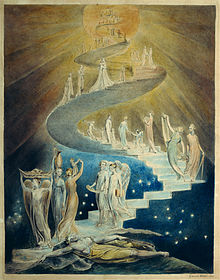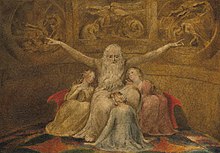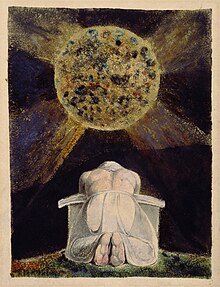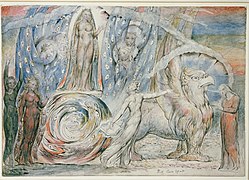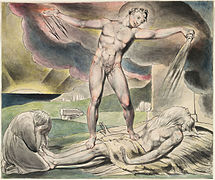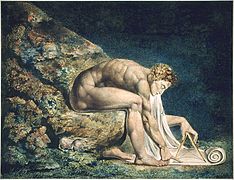William blake
William Blake (28 November 1757 London - 12 August 1827 London) was a British poet, painter and engraver. Although he remained largely unknown throughout his lifetime, Blake's work is held in high esteem today. Because of the relationship that poetry and his respective engravings have in his work, Blake is often held up as an example of the "total artist." According to The Guardian newspaper, "William Blake is by far the greatest artist Britain has ever produced".
Considering Blake's achievements in poetry or the visual arts separately would be detrimental to understanding his work: Blake viewed these two disciplines as inseparable means of a single unified spiritual endeavor. Both are necessary to properly appreciate his work. For this reason, illustrated editions of Blake's work had not been particularly valued in the past, until advances in printing techniques allowed for greater dissemination, making his works more accessible to him.
- To see a world in a grain of sand
- and a paradise in a wild flower,
- hold the infinite in the palm of the hand
- and eternity in an hour.
- (Fragment of Auguries of innocence)
Childhood and family
Blake was born at 28 Broad Street, Golden Square, London, into a new middle-class family, in 1757. His father was a hosier. They are believed to have belonged to a radical religious sect called the Dissenters. Blake's mother, Catherine Wright, and her first husband had belonged to the Moravian Church, and some critics note certain Moravian echoes in Blake's poetry. The Bible was an early and profound influence on Blake, and it would remain a crucial source of inspiration throughout his life.
From an early age Blake had visions, the earliest being when, at Peckham Rye, when he was about nine years old, he saw a tree full of angels "decorating with sparkles, like stars, every branch". According to Blake's Victorian biographer Alexander Gilchrist, after seeing the vision of him she returned to his house and commented on it, escaping a beating from his father through the intervention of his mother. Although all the evidence suggests that the parents were very liberal and supportive of Blake, his mother seems to have been especially supportive of him; several of Blake's early drawings and poems decorated the walls of his room.
On another occasion, Blake watched reapers at work, and saw "angelic figures walking among them." It is possible that other visions occurred before these: later in her life, Blake's wife, Catherine, would remind her of the time she saw the head of God "placed in the window." The vision, Catherine remembered her husband, left him screaming.
Blake began engraving copies of ancient Greek drawings, and his father even bought him some (another indication of his parents' support for him). Blake preferred making these copies to inventing his own drawings. From these drawings, Blake found his first exposure to classical forms, through the work of Raphael, Michelangelo or Albrecht Dürer, artists who did not enjoy equal recognition at the time, but whom Blake believed to be superior to those of the Flemish schools and venetian The influence of these classical works on his paintings can be seen in his later work.
His parents knew of his stubborn temperament and did not send him to school but instead allowed him to attend Henry Pars' drawing school, where he learned the fundamentals of the art. He avidly read the topics that he himself chose. During this period, Blake was also exploring poetry; His early work showed knowledge of Ben Jonson and Edmund Spenser.
Learning with Basire
On August 4, 1772, at the age of fourteen, Blake began his seven-year apprenticeship with James Basire, engraver to the Society of Antiquaries and the Royal Society, at 31 Great Queen Street. Basire's style, which was considered old-fashioned by many, was more suited to Blake's personal style; however, instruction in this outdated form may have later had a detrimental effect on his attempts to acquire work or recognition at the end of his life.
During this time Blake learned the complicated technique of engraving as it was done in England in the late 18th century. Some of Blake's illustrations during this time are thought to have been those of Jacob Bryant's A New System, or an Analysis of Ancient Mythology, and Sepulchral Monuments in Great Britain by Richard Gough. However, many of the works carried out by the apprentices at that time were signed by the master, so we cannot know for sure.
Basire was apparently a good teacher for Blake: there are no records of any serious disagreements between the two during Blake's apprenticeship. However, Blake would later add Basire's name to his list of artistic adversaries, only to cross it off. During his apprenticeship, Basire sent him to make copies of Gothic churches in London, and especially to copy the engravings on the tombs of the kings and queens in Westminster Abbey (possibly ending with a fight between Blake and James Parker, another of the apprentices). The first works that can be attributed with complete certainty to Blake show his interest in British history and legend, later he would unify these works in Joseph of Arimathea among the Rocks of Albion .
Westminster Abbey looked completely different in the late 18th century than it does today, adorned with armor, painted funeral effigies, and multicolored waxwork. It was particularly Blake's experiences in the abbey that began to form in the artist the foundations of his artistic ideas and style. Blake spent many afternoons making sketches of the cathedral, during which he was occasionally interrupted by students from Westminster School. On one occasion a student annoyed Blake so much that he struck him against a scaffolding on the ground, "upon which he fell with great violence." At the abbey, Blake had other visions of a great procession of monks and priests, walking to the sound of "a liturgical chant and a choir."
The Royal Academy
In 1779, at age 21, Blake became a student at the Royal Academy at Old Somerset House. Although his education there did not require any payment on his part, he had to procure his own work materials during the six years of apprenticeship. There he rebelled against what he considered the unfinished style of fashionable painters like Rubens, championed by Joshua Reynolds, the school's first president. Over time, Blake came to hate Reynolds's attitude about art, especially his search for "truth and general beauty." Reynolds in his Discourses maintained that "the tendency to abstraction was the greatest glory of the human mind." Blake, in a private writing, responded that "to generalize is to be an idiot, to particularize is the only distinction of merit." Blake also disliked Reynolds' apparent humility, which he saw as a form of hypocrisy. Artistically, Blake preferred the classical accuracy of his early influences, Michelangelo and Raphael, to the more "fashionable" oils of Reynolds.
In June 1780, while walking to Basire's shop, Blake was swept away by a violent mob storming London's Newgate Prison. The crowd wore cockades (ribbons) on their hats, as a symbol of support for the insurrection of the North American colonies. They attacked prison guards with shovels and picks, before setting the building on fire. The mutineers climbed to the roof and demolished it, freeing the prisoners. Blake was in the front row of the crowd during the attack. Many biographers believe that he accompanied the crowd on impulse.
These riots were in response to a bill in Parliament revoking sanctions against Catholics. They have come to be called the Gordon Riots after lord George Gordon (whose Protestant association incited the riots) and led to a flurry of legislation by the George III government, as well as the creation of the first British police force.
Marriage
In 1782 Blake met John Flaxman, who would become his employer, and his wife, Catherine Boucher. Blake had proposed to another woman and she had turned him down. After telling Catherine and her family her story, at the compassion shown by her, Blake declared that he loved her. They were married on 18 August 1782 at St. Mary's Church, Battersea. Catherine was by then illiterate, and she signed an x her marital contract. Later Blake taught him to read and write, as well as to make engravings. During his lifetime, Catherine was an invaluable help to Blake, helping to print his enlightened works and keeping his cheerfulness steady after numerous misfortunes. Her marriage, though childless, continued faithful and affectionate for the rest of Blake's life.
George Cumberland, one of the founders of the National Gallery, became an admirer of Blake's work. Blake's first collection of poems, Poetical Sketches , was published during 1783. After his father's death, William and his brother Robert opened a printing press (1784) and began working with radical publisher Joseph Johnson. At Johnson's home, Blake met some of the leading dissident intellectuals of his time in England, including the scientist Joseph Priestley, the philosopher Richard Price, the painter Johann Heinrich Füssli, who would later be his friend, the writer and feminist Mary Wollstonecraft and the American revolutionary Thomas Paine. Blake, like William Wordsworth or William Godwin, had high hopes for the French and American revolutions; in fact, he used to wear a red cap as a sign of solidarity with the French revolutionaries. However, his hopes were dashed with Maximilien Robespierre and the Reign of Terror during the French Revolution [citation needed ] .
Mary Wollstonecraft became a close friend of Blake, who illustrated his Original Stories from Real Life (1788). They seem to have had similar views on the equality of the sexes and the institution of marriage. In Visions of the Daughters of Albion of 1793, Blake condemned the absurd cruelty of chastity and loveless marriage and defended the right of women to complete self-realization.
In 1788, Blake began experimenting with etching, the method used to illustrate most of his books of poetry. This process is also called illuminated printing and its product is called illuminated books or illuminated prints. Illuminated printing involved writing the text of the poems on copper plates with pens and brushes, using an acid-resistant medium. Illustrations could appear alongside the text, as in medieval illuminated manuscripts. He then dipped the plates in acid to dissolve the untreated copper and leave only the design. The pages printed with these plates had to be recolored by hand with water-based paints and then stitched together to form a volume. Blake used this technique in four of his works: Songs of Innocence and Experience, The Book of Thel, The Marriage of Heaven and Hell and Jerusalem.
Social stance
Blake hated slavery and believed in gender and racial equality. Several of his poems and paintings express a notion of universal humanity. He retained an active interest in social and political events throughout his life, though he was often forced to disguise social idealism and transform political statements into mystical Protestant allegories. Blake rejected all forms of imposed authority: in fact, he was accused of assault and uttering revolutionary or seditious expressions and treason against the king, in 1803 but he was acquitted of these charges at the Chichester sessions.
"Every existing thing has as much right to Eternal Life as God, who is the servant of man”
In his latest works, an extension of his social theme can be observed, since a careful reading of his works and without ideological prejudices allows us to find in them an analysis of the industrial revolution and colonialist expansionism without precedents in Blake's own work nor in the literature of the time. Proof of this is the following passage from The Four Zoas, where all the concepts outlined by Blake in his previous prophecies appear tied up with historical references, and whose ideological disclosure of expansionist imperialism maintains an overwhelming validity to this date.:
“...in his deepest bowels, in the darkest night, where Urizen has his seat, the shadow sprang.
And Urizen saw, and triumphed, and proclaimed his warriors:
‘ The time of Prophecy is over, and all this universal shorthand now I possess, the threads of heaven that my hands will weave like a robe on my shoulders.
Consuming in power and glory what must be consumed
I will walk through the vast fields of Eternity.
A God, not a man; a conqueror snatched from glory... ’
He first built the corporations, commercial ships and armed ships to surveil the seas, while on land the children sell themselves to the industry in the most painful conditions, working day and night, until their life extinct, and spectral forms adopt in their bleak desperation.
To thousands the slaves, piled up in the wineries, cross the gulf.
Smooth its chains, the Universal Empire groans.”
For Blake, liberation implied a radical change in human perception. Said change was closely interrelated with the abolition of the concrete oppressive systems of his time: Church, oligarchic State and Empire.
Fragment taken from his work Jerusalem.
"Where is the Tree of Good and Evil, which rooted under the cruel heel of the Wraith of Albion, the Dry Patriarch? Where did their atoning human sacrifices, perpetrated in the war and in the Druid temples of the Inquisitor, the Albion oakdales that under their Spectrum the Earth darkened?
Where are the kingdoms of the world in all their glory, built upon the desolation, the fruit of the Tree of the Poverty of Albylon, when their giant Gog-Magog tricephalus imposed taxes on the nations setting up the desolation in them...?”
Last years and works
Although the marriage between Blake and Catherine was happy and devoted until the end of their lives, there were early problems, such as Catherine's illiteracy and their failure to have children. At one point, following the beliefs of the Swedenborgian Society, Blake suggested bringing a concubine; Catherine was embarrassed by the idea and Blake dismissed it.
Blake later sold a large number of his works, especially his Bible illustrations, to Thomas Butts. Around 1800, Blake moved to a country house in Felpham (now West Sussex), to carry out the work of illustrating the works of William Hayley, a mediocre poet. It was here that Blake wrote Milton: a Poem, which would be published between 1805 and 1808.
Blake's views on oppression and the restriction of liberties extended to the Church. Blake considered himself a follower of Unitarian philosophy, and also claimed to be Chosen Chief of the Ancient Druid Order from 1799 to 1827. His spiritual beliefs are noted in the poems of Songs of Experience (1794), in which Blake makes a distinction between the God of the Old Testament, whose restrictions he rejected, and the God of the New Testament (Jesus Christ), whom he considered a positive influence.
Blake returned to London in 1802 and began writing and illustrating Jerusalem (1804 to 1820). He was introduced by George Cumberland to a young artist, John Linnell. Through Linnell, Blake met Samuel Palmer, who belonged to a group of artists called the "Shoreham Ancients." This group shared Blake's rejection of modern trends and his belief in a new spiritual and artistic age. At the age of 65, Blake began working on the illustrations for the Book of Job. These works were praised by John Ruskin, who favorably compared Blake to Rembrandt.
William Blake died in 1827 and was buried in an unmarked grave in Bunhill Fields Cemetery, London. A monument for him and his wife was erected near the site, which was completed in 2018. His life could be summed up in his statement: "Imagination is not a state: it is human existence itself.". Blake has been recognized as a saint by the Ecclesia Gnostica Catholica. In 1949 the Blake Prize for Best Religious Art was established in his honor in Australia.
William Blake and painting
Blake's painting, based on fantastic visions of rich symbolism, has a certain influence from Michelangelo, due to the musculature of his figures and the foreshortenings to which he subjects them. He applied his pictorial art to illustrate both his own compositions and those of others: Paradise Lost by Milton (one of his favorite works), or Nights , by Edward Young. The relationship between the poems and the illustrations is complex and requires imagination on the part of the reader, since it is based not so much on the theme of the poem itself as on the feeling it conveys.
Work
As Kathleen Raine points out, “For Blake, living according to Imagination is the secret of life. The “gods” of reason, feeling, inspiration and physical senses are nothing more than aspects of that unique life of Imagination, “the very human existence” that covers everything together. There is nothing outside of Imagination, which is immortal, eternal and inexhaustible."Carlos Javier González Serrano
Illuminated books
- h.1788: All Religions are One
- There is No Natural Religion
- 1789: Songs of Innocence (Songs of innocence).
- The Book of Thel
- 1790-1793: The Marriage of Heaven and Hell (The Marriage of Heaven and Hell)
- 1793: Visions of the Daughters of Albion (The visions of the daughters of Albion)
- America: a Prophecy (America: a prophecy)
- 1794: Europe: a Prophecy (Europe: a prophecy)
- The First Book of Urizen (The book of Urizen)
- Songs of Experience (Songs of experience)
- 1795: The Book of Los
- The Song of Los
- The Book of Ahania
- h.1804-h.1811: Milton: to Poem" (Milton: a poem)
- 1804-1820: Jerusalem: The Emanation of The Giant Albion (Jerusalem)
Not enlightened
- 1783: Poetical Sketches
- 1786: An island on the moon
- 1789: Tiriel
- 1791: The French Revolution
- 1797: The Four Zoas
Illustrated by Blake
- 1791: Mary Wollstonecraft, Original Stories from Real Life
- 1797: Edward Young, Night Thoughts
- 1805-1808: Robert Blair, The Grave. These prints were recorded by Louis Schiavonetti from the originals of William Blake and were reprinted for the book Poetic Meditations by José Joaquín de Mora, who was inspired by the creation of twelve poems of their own.
- 1808: John Milton, Paradise lost.
- 1819-1820: John Varley, Visionary Heads.
- 1821: R.J. Thornton, Virgil.
- 1823-1826: The Book of Job.
- 1825-1827: Dante, The Divine Comedy (laughing)
Spanish edition
- William Blake. Eternal vision. Letters, manifests and essays. Selection, translation and editing by Javier Calvo, hard cover, Collection Artefactos. Editorial La Felguera. 2021. ISBN 978-84-122610-5-9.
- Auguries of innocence. Bring. Fernando Castanedo. Madrid: Editions Chair. 2020. ISBN 978-84-376-4130-0.
- All religions are one / No natural religion. Trad. David Francisco. Zaragoza: Question Editions. 2014. ISBN 978-98-943044-2.
- An island on the moon. Bring. Fernando Castanedo. Madrid: Editions Chair. 2014. ISBN 978-98-376333-4-3.
- Illustrations to the Book of Job. Javier Calvo's prologue. Raquel Duato. Madrid: La Felguera Editores. 2014. ISBN 978-98-942187-3-6.
- Prophetic Books by William Blake. Foreword Patrick Harpur. Bring. Bernardo Santano Moreno. Two tomos, I cartoned. Imaginatio Vera Collection / Catena Aurea. Vilaür: Editions Atalanta / Buenos Aires: Editorial The thread of Ariadna. 2013, 2014. ISBN 978-84-940941-5-6 / ISBN 978-987-29896-5-1 (Volume I) ISBN 978-84-942276-2 / ISBN 978-987-3761-08-9 (Volume II).
- Complete Poetry. Bring. Andrés Maldonado. Buenos Aires: Editorial Cygnus. 2012. ISBN 978-98-7239-844-6.
- See a world in a grain of sand. Bring. Jordi Doce. Bilingual edition. Madrid: Visor Books. 2009. ISBN 978-84-9895-021-2.
- Marriage of heaven and hell. Seville: Renaissance. 2007. ISBN 978-8472-336-3.
- The devil is parchment: aphorisms(exhausted). Mexico: Verdehalago. 2006. ISBN 968-9103-10-5.
- Tiriel: The book of Thel. Madrid: Artemisa editions. 2006. ISBN 84-96374-39-4.
- Marriage of heaven and hell. The Songs of Experience. Madrid: Visor Books. 2003. ISBN 978-84-7522-087-1.
- The Marriage of Heaven and Hell. Bring. Fernando Castanedo. Madrid: Editions Chair. 2002. ISBN 84-376-2000-7.
- Selected prose. Barcelona: Dvd editions. 2002. ISBN 84-95007-68-1.
- Milton: a poem. Barcelona: Dvd editions. ISBN 84-95007-69-X.
- The book of Urizen. Madrid: Editions Hiperion. 2002. ISBN 978-84-7517-737-3.
- Bilingual anthology. Madrid: Editorial Alliance. 2002. ISBN 84-206-7326-9.
- The amazons: a study of Athenian myths. Madrid: Fund of Economic Culture. 2001. ISBN 84-375-0516-X.
- The woods of the night. Valencia: Pre-texts. 2001. ISBN 84-8191-402-9.
- The Marriage of Heaven and Hell. (3rd edition). Madrid: Editions Hiperion. 2000/2005. ISBN 978-84-7517-646-8.
- Jerusalem, the emanation of the giant Albion. Castellón: Universidad Jaume I. Communication and publications service. 1997. ISBN 84-8021-122-9.
- Songs of innocence and experience. Madrid: Editions Chair. 1987. ISBN 84-376-0668-3.
- Blake. Complete poetry. (6th edition). Barcelona: Editions 29. 1984/2003. ISBN 84-7175-372-3.
- Blake. Complete Poetry (Bilingual Edition). (Two tomos) Barcelona: Editorial Río Nuevo. 1980. ISBN 84-7175-185-2.
- Songs of innocence. Songs of experience. Barcelona: Editorial Bosch. 1977. ISBN 84-7162-690-X.
- Poems and Prophecies. Editions Assandri, Córdoba, Argentina. Translation by Enrique Caracciolo Trejo. 1957.
Contenido relacionado
E.E. Cummings
Luis de Gongora
Alvaro del Amo
Rodolphe Topffer
Miquel Barcelo Garcia
